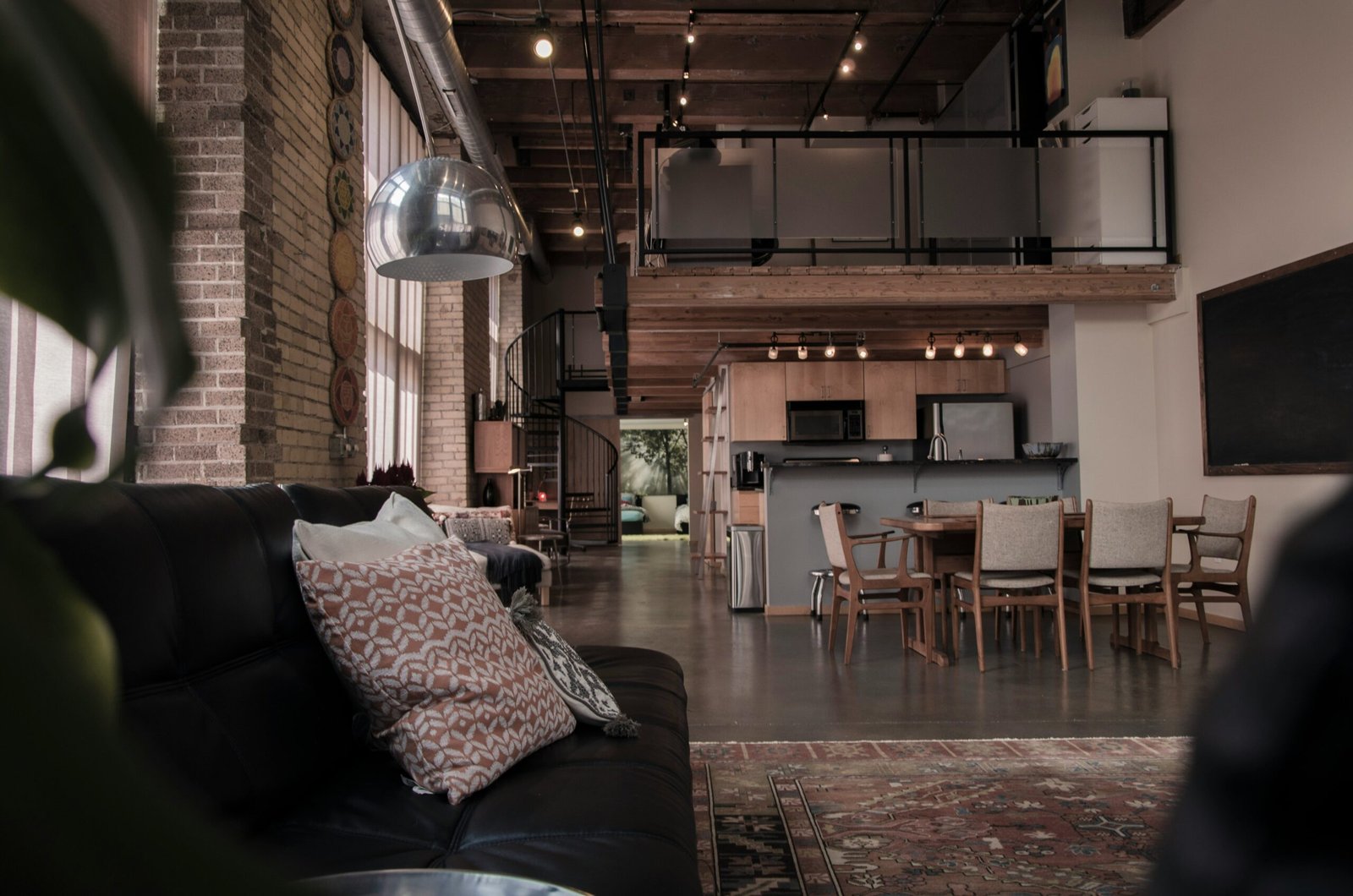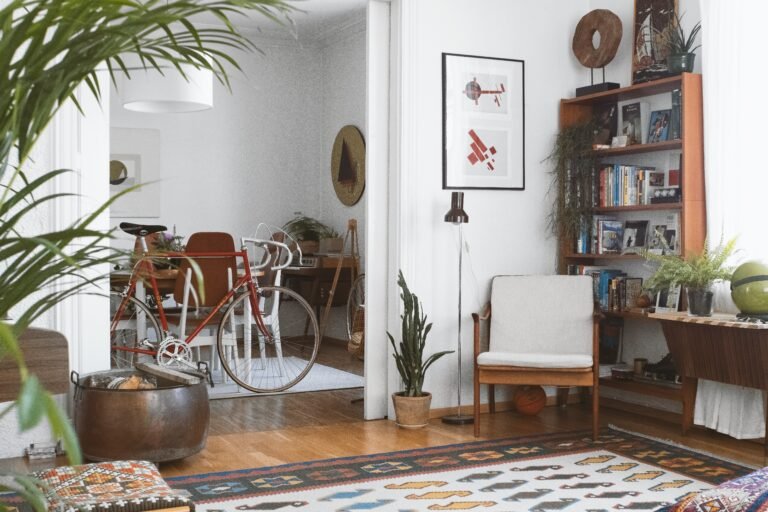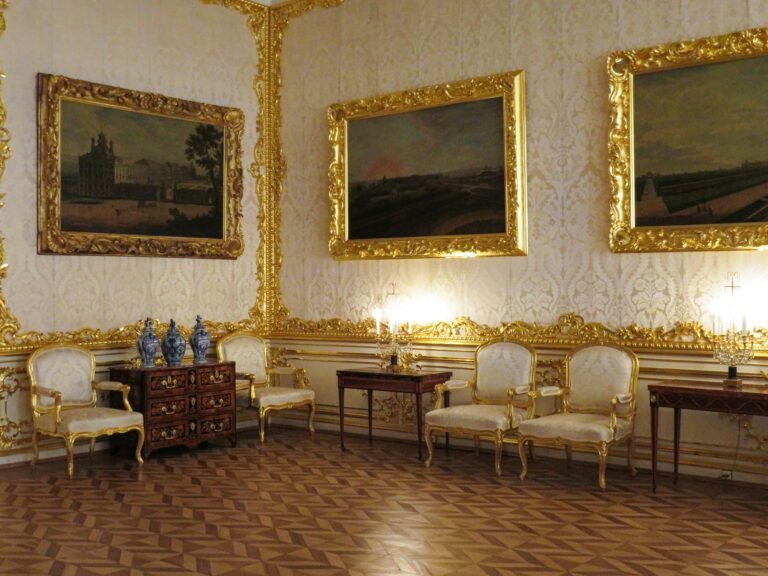Over the years of writing and working around interior spaces, I’ve seen design trends come and go. Yet few have the staying power of industrial style interiors. Rooted in the authenticity of factories and warehouses, this look has evolved from utilitarian necessity into a celebrated aesthetic. What draws people in is its honesty—exposed pipes, raw materials, and unpolished textures that tell a story of hard work and resilience.
When I first walked into a loft with towering windows and steel beams left uncovered, it felt like stepping into a space that breathed history while remaining entirely modern. That’s the magic of this design approach: functionality paired with urban charm. In the following sections, we’ll explore where it began, the core elements that define it, and how to apply those principles to your own home or workspace.
The Origins and Core of Industrial Style Interiors
Industrial interiors were never meant to be “styled” in the beginning. They emerged in the early 20th century when abandoned warehouses and factories in cities like New York and London were repurposed into living spaces. Instead of concealing their rugged structures, architects celebrated them, showcasing exposed brick design, steel beams, and raw concrete.
Several defining features grew from these origins:
- Structural honesty
Nothing is hidden. Exposed ductwork, ceiling pipes, and raw timber become part of the visual language. According to Architectural Digest, leaving these materials uncovered allows the building’s character to shine through. - Neutral palettes with depth
Industrial interiors thrive on shades of black, grey, and white, often softened by wood or leather accents. This muted approach creates calm, grounding spaces while providing a perfect canvas for artwork or modern furniture. - Open layouts
The loft aesthetic interiors are rooted in high ceilings, wide windows, and unobstructed spaces. Large, airy rooms once used for machinery are now flooded with light, making them ideal for creative studios or flexible living areas (BBC Maestro). - Functional furniture
Inspired by Bauhaus minimalism, industrial chic decor often includes steel-legged chairs, reclaimed wood tables, and worn leather couches. Each piece is chosen less for ornament and more for utility, while still creating visual impact (Rowabi).
For me, what makes these elements resonate is their authenticity. Unlike highly polished design styles that sometimes feel staged, industrial interiors embrace imperfections. A weathered brick wall isn’t just a backdrop—it’s a reminder of the building’s past life, grounding the space in something real and lasting.
What Makes Industrial Chic Decor Timeless
One reason industrial chic decor has remained popular for decades is that it doesn’t rely on passing fads. Instead, it celebrates honesty and adaptability. From my perspective, the beauty of the style lies in how easily it can evolve. What worked in a converted warehouse in 1980 still feels relevant in a downtown apartment today.
Experience: Living the Look
When I helped a friend style her loft in Brooklyn, the challenge wasn’t filling the space with trendy items, it was letting the space breathe. The aged beams and steel columns already carried so much presence that we simply layered in neutral textiles and industrial lighting. That’s when I realized this style thrives by amplifying what’s already there rather than covering it up.
Expertise: The Architect’s Perspective
Design experts often point out that industrial interiors provide a blank canvas for creativity. Raw brick or concrete doesn’t restrict a designer, it allows them to build contrast with sleek glass, soft upholstery, or even vibrant modern art. According to Architectural Digest, this balance of rough and refined is exactly why the look remains timeless.
Authoritativeness: A Global Consensus
From New York’s loft conversions to London’s warehouse apartments, authoritative voices across the design world recognize the industrial style as more than a trend. Publications like BBC Maestro describe it as a design language that has shaped urban living for decades, cementing its place as a reliable style choice.
Trustworthiness: Authentic Materials Matter
If there’s one principle that ensures industrial spaces don’t feel artificial, it’s authenticity. Using genuine reclaimed wood, real stone, or actual steel rather than faux finishes builds trust in the design. As Rowabi notes, the style is as much about honesty as it is about aesthetics – imperfections are embraced, not hidden.
Incorporating Industrial Style Interiors in Your Home
The beauty of industrial design is that you don’t need to live in a converted warehouse to embrace it. With a few deliberate choices, you can capture the same urban aesthetic in any space, whether you own a suburban home or rent a small apartment.
Highlight Structural Honesty
One of the quickest ways to bring an industrial feel into your interiors is by exposing what’s already there. If you’re lucky enough to have original beams, ducts, or brickwork, leave them uncovered. When those elements aren’t available, you can mimic the look with exposed brick design panels, distressed wood overlays, or even textured concrete finishes on feature walls.
I’ve found that even something as simple as exposing a section of pipe or keeping ductwork visible instead of boxing it in can transform a space. It signals authenticity, which is at the core of this style.
Use a Neutral Palette with Warm Accents
Industrial interiors often rely on a foundation of greys, whites, and blacks. These muted tones provide calmness while allowing architectural details to stand out. But too much grey can make a room feel cold.
To balance this, add warmth with wood furniture, tan leather, or rust-toned textiles. I often suggest layering a reclaimed wood dining table with soft linen chairs, it keeps the room grounded but inviting.
Functional Furniture with Style
Furniture in this style is never fussy. Instead, it’s chosen for its practicality, durability, and clean lines. Look for pieces with steel or iron frames, leather upholstery, or reclaimed wood tops.
I personally lean toward Bauhaus-inspired chairs and industrial stools. They’re not only durable but also serve as conversation starters. Less is more here; clutter detracts from the raw aesthetic.
Industrial Lighting Trends that Transform a Room
Lighting is one of the most powerful tools in this design style. Current industrial lighting trends include oversized pendant lamps, Edison bulb fixtures, and matte black sconces. These not only illuminate a space but also act as sculptural features.
For example, I once installed a trio of warehouse-style pendant lights above a kitchen island. The glow from the exposed bulbs gave the room warmth while reinforcing the industrial vibe. According to Architectural Digest, lighting in this style is as much about atmosphere as it is about functionality.
Balance Raw with Refined Comfort
While industrial interiors celebrate rugged materials, no one wants to live in a space that feels like a factory floor. To keep things livable, layer in comfort: plush area rugs, velvet cushions, and soft throws.
I’ve often advised clients to add at least one oversized sofa with deep seating. It softens the room’s edges without undermining the industrial mood. It’s this balance between raw and refined that makes the style appealing to such a wide audience.
Modern Evolutions: Sustainability, Tech, and Steel Sculptures
While the foundations of industrial style are rooted in 20th-century warehouses, the design has not stayed frozen in time. Instead, it has evolved to embrace modern priorities like sustainability, technological convenience, and bold materials. These shifts prove that industrial chic decor can adapt without losing its rugged soul.
Eco-Friendly Materials and Conscious Choices
One of the most significant changes in recent years is the emphasis on eco-friendly materials. Designers and homeowners alike are sourcing reclaimed wood, recycled metals, and low-impact concrete alternatives. According to The Interior Design Institute, this sustainable approach not only reduces waste but also enhances authenticity.
Personally, I find reclaimed wood tables or shelving units carry a richness that new materials can’t replicate. The imperfections like the dents, scratches, and patina become design details that celebrate the passage of time.
Smart Technology for Modern Living
Industrial style may lean on history, but that doesn’t mean it ignores innovation. Smart home technology has been seamlessly integrated into industrial interiors, from voice-controlled lighting systems to hidden speakers tucked behind brickwork. Touch-panel controls and wireless automation allow these rugged spaces to function like cutting-edge homes without compromising their character.
I’ve visited lofts where steel-framed walls cleverly concealed modern wiring and sound systems. The result was a living environment that felt both timeless and futuristic.
Stainless Steel as a Design Statement
In kitchens, staircases, and even furniture, stainless steel is making a strong comeback. The Financial Times recently highlighted the rise of stainless steel not just as a functional surface but as a sculptural, reflective material in contemporary interiors.
The sharpness of steel contrasts beautifully with warm woods and textured fabrics, giving industrial spaces a modern edge. I once saw a dining room where a polished steel table became the centerpiece. It reflected the brick walls and pendant lighting, adding drama and depth without overwhelming the room.
Balancing Past and Present
The key to these modern evolutions is balance. Industrial interiors thrive when history and progress coexist, when reclaimed beams meet automated lighting, or when rustic brick walls frame sleek stainless steel. This interplay keeps the style relevant and forward-looking while honoring its roots.
Industrial Interiors Beyond Homes: Urban and Commercial Inspirations
Although industrial design is beloved in modern homes, its true influence is often most visible in urban and commercial spaces. From chic cafés to boutique hotels, this style has become synonymous with creativity, innovation, and cosmopolitan living.
Loft Aesthetic Interiors in City Living
Cities like New York, London, and Berlin played a pivotal role in the spread of industrial style. During the mid-to-late 20th century, artists began converting abandoned warehouses into loft apartments. With soaring ceilings, wide windows, and exposed beams, these loft aesthetic interiors offered a sense of freedom that traditional housing could not. According to BBC Maestro, this urban repurposing of space helped cement industrial interiors as a cultural phenomenon.
I remember walking into a SoHo loft years ago, where brick walls were lined with massive bookshelves and steel-framed windows stretched from floor to ceiling. The space felt like a canvas, open, raw, and alive with potential. That experience made me realize how powerful an open, industrial layout can be in inspiring creativity.
Industrial Design in Hospitality
Hotels and restaurants have embraced the rugged charm of industrial interiors to create memorable atmospheres. In Brooklyn, the Wythe Hotel – converted from a 1901 factory – retains original timber beams and masonry walls while adding modern comforts. Guests often say they feel connected to the building’s history, which adds authenticity to their stay.
Cafés and breweries also favor industrial design. With Edison bulb lighting, communal wood tables, and concrete floors, these spaces feel approachable and genuine. The rawness of the materials often makes conversations and gatherings feel more relaxed and organic.
Offices with an Industrial Edge
Industrial design has also shaped the modern workplace. Exposed ceilings, steel staircases, and polished concrete floors are now common in creative agencies and tech startups. The openness of the layout fosters collaboration, while the mix of raw and sleek surfaces signals innovation.
When I toured a co-working space in London’s East End, I was struck by how the industrial bones of the building, once a textile factory, created an environment that felt both grounded and forward-thinking. It wasn’t just a place to work; it was a space that inspired bold ideas.
A Universal Appeal
Whether in loft apartments, boutique hotels, or bustling offices, industrial interiors communicate a universal language: authenticity. They remind us of history, celebrate craft, and adapt seamlessly to modern needs. That’s why the style has spread far beyond the home and continues to thrive in cities worldwide (Wikipedia).
Pitfalls to Avoid — Keeping Industrial Inviting
Industrial design has undeniable appeal, but like any style, it can go wrong if not approached thoughtfully. Too much emphasis on rawness or minimalism can tip the balance from stylish to sterile. Over the years, I’ve seen a few recurring mistakes and they’re surprisingly easy to avoid.
Mistake 1: Going Too Cold and Stark
Raw concrete floors, bare walls, and exposed pipes look striking – but when overdone, they can feel more like an empty warehouse than a welcoming home. According to The Sun, overly cold interiors may even make a property harder to sell.
Fix: Add warmth with textiles – think large area rugs, plush throws, or even velvet cushions. Mixing textures softens the hard edges and makes the space feel lived in.
Mistake 2: Overcluttering the Space
Because industrial interiors often feature open layouts, clutter stands out more. I’ve seen lofts where too many small decorative items disrupted the sense of flow and simplicity that makes this style appealing.
Fix: Stick to a minimalist approach. Choose a few bold, functional pieces of furniture and let them breathe. Less is truly more here.
Mistake 3: Ignoring Lighting Variety
One common oversight is relying solely on overhead fixtures. While pendant lights and Edison bulbs are staples of industrial lighting trends, they shouldn’t be the only source of illumination. A single harsh light can make a room feel flat and uninviting.
Fix: Layer your lighting. Combine pendants with floor lamps, wall sconces, and even candles. Multiple sources create warmth and depth.
Mistake 4: Forgetting Comfort
Industrial style doesn’t mean living in a factory. I once visited an apartment where every surface was metal or concrete. It looked bold, but sitting down anywhere felt uncomfortable.
Fix: Balance rugged textures with comfort-driven design. A large leather sofa, soft textiles, or even greenery can make the space feel welcoming without losing its industrial edge.
Mistake 5: Faking It Too Much
While it may be tempting to use faux finishes to replicate exposed brick or aged wood, going overboard can make a space feel inauthentic. Industrial design thrives on honesty.
Fix: Where possible, use real reclaimed materials—even in small doses. A single reclaimed wood coffee table has more impact than an entire room of faux brick wallpaper.
By avoiding these pitfalls, you can preserve the raw beauty of industrial style while ensuring your home or workspace remains comfortable and inviting.
Conclusion
At its core, industrial style interiors are about celebrating authenticity—letting raw materials, functional design, and urban character shine. From their origins in converted factories to their modern evolutions with sustainable materials and smart technology, industrial spaces strike a rare balance between history and progress.
What I’ve always loved about this style is its honesty. A weathered brick wall, a reclaimed wood table, or an exposed steel beam doesn’t need embellishment. These elements tell their own stories while creating a backdrop that’s endlessly adaptable, whether in a cozy apartment, a creative office, or a boutique hotel.
If you’re ready to bring this timeless aesthetic into your own space, here are a few takeaways to guide you:
Actionable Takeaways
- Start small but bold — introduce one statement feature like exposed brick or an oversized industrial pendant light.
- Layer in warmth — balance concrete and steel with textiles, wood tones, and greenery.
- Embrace sustainability — choose reclaimed wood, recycled metal, or low-impact finishes.
- Blend tech with tradition — integrate smart lighting or hidden speakers without losing raw charm.
- Stay authentic — let imperfections and genuine materials be part of the design story.
Industrial interiors aren’t just about style; they’re about substance. They merge functionality with urban aesthetics in a way that feels both grounded and forward-looking. A design language that proves comfort and character can thrive side by side.
FAQ: Industrial Style Interiors
Alex is the creator of Homely Haven, a space dedicated to simple, stylish ideas for interiors and gardens alike. With a passion for cozy living rooms, inviting outdoor spaces, and practical DIY solutions, Alex shares tips and guides that help turn any house into a true home.
From budget-friendly decorating hacks to weekend garden projects, the goal is always the same: to inspire you to create spaces that feel personal, beautiful, and welcoming. When not writing, Alex is usually rearranging furniture, sketching new garden layouts, or exploring design trends for the next project.








